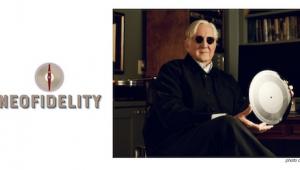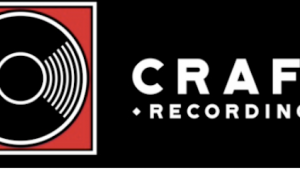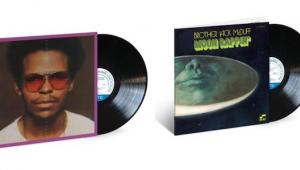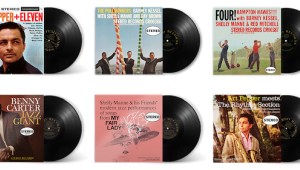:)
Ending the Peter, Paul & Mary Mystery!
The two files are different. Both use the same record, the same cartridge (Lyra Etna), same tone arm (Kuzma 4 Point), the same turntable (Continuum Caliburn), the same phono preamp (Ypsilon VPS-100/MC-10L transformer) and same A/D converter (Ayre QA9).
So what is different? Kuzma offers a 4 Point wiring option that includes two sets of tone arm wires (Crystal Cable), both soldered to the same cartridge clips. The wires run through the arm, with one set terminating in a meter or so length of interconnect terminated with RCA plugs. So that one is a "direct through" connection with no breaks.
The other set connects to a junction box about six inches from the wire's exit at the back of the arm fitted with a pair of RCA jacks. This option allows users to experiment with various brands of tonearm wire, similar to how many tone arms today are terminated.
I had put the Thales phono cable ($2000 for 1.5 meters) in a few days before getting ready for CES and began recording files to take to the show but in the rush to CES I'd forgotten.
When I recorded the familiar Peter, Paul & Mary track I thought Peter's voice had an unfamiliar edge and then I remembered the switch. So I went back to the 'straight through' connection and recorded it again. What I heard then is what most CES listeners heard and what most of you heard here! And you did it "blind"!
21% thought the files were identical. You were wrong. 43% preferred File "A" and 36% preferred File "B". File "A" is the Thales cable. File "B" is the "straight through Crystal Cable. Here's where the comments come in: most listeners heard the same thing, even though they differed in how they responded.
The "A" file definitely sounds slightly brighter, with more of a transient "edge" (one of you measured it!) that some preferred. "Quicker transient peaks" one of you wrote. They found File "B" sounded dull or rolled off.
The "B" file definitely sounds smoother, which some preferred as being more "whole". To those respondents, File "A" sounded "a bit hard over all". Another found "A" "a bit strident". Someone even thought File "B" might have been cleaned up with software. Another thought the Spotify version sounded better than either file. To each his own!
One person summed up my conclusion: "A is tipped up ever so slightly. I can see A's appeal. Over time, it would cause more listener fatigue as its voicing is a little less natural than reality. B is long haul winner I'd want to marry. Maybe date A for a night" ("date" being a euphemism).
The bottom line is: which you prefer is a matter of taste and associated equipment but that's not what's important here. What's important is that in a blind listening test, most of you were able to hear the differences between two tone arm cables, without knowing it was a cable comparison! And you were able to describe them with not-surprising consistency. One man's "bright" is another man's "fast and clean." Another man's "smooth and natural" is another's "dull."
So what will cable difference deniers say now? Oh, that's easy! First they'll say the "break" versus the straight through makes this an invalid test. Secondly they'll say that the first play "shaved off" the high frequencies so the second file sounded smoother. To them I say what Dick Cheney said to Patrick Leahy on the Senate floor some years ago, which I'm sure most of you know and if you don't you can look it up.
Nothing will change their opinion that cables don't matter so who cares what they think? You know better. And if the slight brightness was caused by the connection and not the cable, for some of you it would mean considering modifying your arm for a "straight through" connection. Or not!
The bottom line: 43% preferred the Thales cable. 36% the straight through Crystal Cable (myself included). Thanks to everyone who participated. You proved yet again that analogplanet.com has the best readers!
- Log in or register to post comments


"Super low", perhaps, but non-zero nonetheless.
You can calculate the difference in the ultrasonic resonant peak here: http://www.hagtech.com/loading.html
It's suggested on this site ( http://www.extremephono.com/Loading.htm ) that "the elevating top-end caused by improper loading can sometimes be perceived as 'air' or high-frequency extension, but in reality, it is actually odd-harmonic high frequency distortion. In a very well balanced reproduction system, it will sound edgy and bright."
Isn't that the sort of difference that seems to have been detected?

Did you do the calcuation on the hagtech site using the inductance of the Etna?
The value of the ultrasonic peak still varies with changes in capacitance, which will affect the bandwidth/rise time of the system, perhaps audibly.
Or is there (also) some constructive/destructive interference from reflections in the signal caused by the extra connections/terminations in the junction box?
What's your rationale for the apparent perceived difference in sound quality?

Was it not John Curl who stated that one of the principle advantages of moving coil cartridges is their extended ultrasonic frequency response?
Again, if you use the calculator on the hagtech site and input the inductance for the Etna (which Lyra specs as 11mH) and then input various values of load capacitance, you can see the change in resonant frequency. For example, with a load of 58pf, say, the resonant peak occurs at about 200kHz. With 470pf, the resonant frequency moves down to 70kHz.
Is it not conceivable, then, that any such variation in ultrasonic frequency response might produce some audible artifacts?

Harman-Kardon used to claim that amplifier response out to at least 80kHz was necessary for accurate reproduction and the Excelinear adjustment on the Hafler XL-280 varied the amp's response at ultrasonic frequencies.

After listening to the 80's CD of KOB twice today, then a 24 bit download rip of Classic's stereo version plus an original mono rip then 1/2 an hour trying to decipher any difference between these 2 files I'm spinning at Vertigo Rate!
In any even, this was a pretty cool comparison test Mikey and I even got a few non-readers listening in while our girlfriends and wives could care less! :)
Things were much easier when I was a kid having an old Fisher receiver paired with Dynaco speakers and a Dual TT.

These comparisons are great fun and a real test to those who claim to have golden ears. For me, being 66 and having my hearing damaged on one to many military firing ranges, I am glad that I can make out minute differences, still. I can hear the differences in wire.
With my lack of HF abilities I do not hear "bright" very often and if I ever do, you know it IS very bright. I seam to be more irritated by a "graininess" that I often hear in HF content of music.
But, still it is one of the reasons that I am a big fan of Grado headphones, but my AKG 701's are my main cans. I used my Grado 80s for this test. I really need a pair of 225's. I also need to upgrade to a very good USB dac which would help greatly.
Michael, thanks again, and I hope you can find the time and energy to keep these tests coming.

His exam and one's ability to evaluate audio equipment have nothing to do with one another. We've all heard the story about the 80yr old, hearing impared conductor that can hear a slightly mistuned violin while the orchestra is playing loudly

...must irritate equipment manufacturers. Imagine, buyers making up their own minds based on actual listening! What next, ignoring marketing and thinking for yourself? It's then end of civilization as Don Draper knows it.
Seriously, keep up the good work! I really like that you didn't tell what, if anything, you changed between the two samples. Pre-conceived expectations were thus minimized.
Imagine if your approach was employed in other fields...LIKE POLITICS!

you're using the medium for what it's designed to do and every other reviewer online since the birth of the web has failed to do. audio reviewing online to date has only taken advantage of the web's immediacy. you've opened up a whole new ball game. not suprised it was you.

Thank you again Michael. I have a Kuzma 4 point ( I had interest in this tonearm because of you) and I've tried three diferent cables: the serial Nordost, direct to the phonostage, Zensati 3 with the 5 pins connector and Zensati Seraphim with 5 pins and the difference in sound is very remarkable, at least for me.... It's a real pleasure read your posts, (most of my circle of friends see me as a odd guy), so it's a relief and a pleasure to feel that there people with the same taste for the music and the good sound.
Regards from Madrid, Spain!

Though surprised by my preference for A - especially since I've been researching which tone arms can be had with direct wiring (Clearaudio and Origin Live arms look interesting).
Regarding the side thread on capacitance / inductance - I would love to see Mr. Fremer explain the issue and provide any tips he has on how to get the best set up! I haven't seen good information on this topic, yet.
thanks, again!

I was considering it when I was looking for a new phono stage (ended up going with the Lounge Audio LCR MK-II) and was curious what you think of it.

My take on the entire reproduced-sound thing has been for years that I'm perfectly willing to accept that everything makes a difference. The two follow-up questions are: 1) Can I hear it? and 2) Can I afford it? This is another example that things do make a difference.

I couldn't have predicted the responses based on what I'd heard for myself.
My intial impression was that B was the "brighter" one but that was likely confusing B's smoothness for "dull" which of course it's not. I wonder if I'd listened to B first I'd have concurred A had the "edge". In other words, what you hear second, due to familarity, can influence opinion about the first.
Regardless, I preferred B but didn't immediatley know why. As I mentioned just now in the other post (my vote today wasn't part of the tally) I noticed more overal defintion in B, with hand taps (or something) keeping the beat against guitar (I'm guessing) being more clear and more vocal dynamics ...
Naturally, I had to listen again to see where by biases and perception figured into this. While I hadn't really noticed the edge in Peter's voice it was amazingly obvious now that was the reason for not just the smoothness but also the increased definition --- it's a real voice, not a recorded one so much.
Now think about that: It's a backwards way of reaching an opinion: The conclusion (preference) hits you first and later you understand why. For many people, they won't and can't think this way and let's just say they're going to be more challenged when asked to identify something, because their objectivism (which let me tell you, your ear/brain team cares NOTHING about) has to know upfront what's going on, howsoever irrelevant to the sound that is.
The inexperienced will always equate treble=detail. This is the biggest lesson to relearn in high end stereo listening, in my opinion, and it's one reason why people who've never heard better prefer shitty lossy files, which are geared towards fulflling their limited expectations.

Obviously I agree above, there was a difference and that B can be justifiably explained as being more true to the recording and the music.
What we seem to be saying here is that in this context the $2000 phono cable [alone] harmed the sound.
Would the makers of high end RCA jacks agree they all sound the same, or that anytime you make a new connection it opens up the possibilty of a change in sound?
I promise you I don't want to see a test of RCA jacks just yet.

Would really like to see more like it.
When I sat down to listen to these my wife was in the room. She knew I was comparing two tracks, but had no idea why. After the second file finished, she immediately said: "The first one sounded better (file A)". I asked why she said that, and she replied: "The second one sounded dull". Though I didn't agree with her, it made total sense as she was sitting at the opposite end of the room facing away from the speakers. She is quite familiar with my audio addiction, and enjoys good sound herself, but she is far from a critical listener. Yet she immediately had a preference. When I saw this results article, I showed her on my turntable what had been changed. She was pretty shocked that it could make such a noticeable difference. I'm looking forward to playing these for some of my skeptic friends to see what they have to say.
Thanks Mr. Fremer!!! This was an awesome test!

Michael, you said:
"What's important is that in a blind listening test, most of you were able to hear the differences between two tone arm cables, without knowing it was a cable comparison! "
Sorry, that's just misleading and wrong. Check out the poll. It was basically 50-50 with quite some people saying they sounded the same. You cherry-picked the answers that support your POV and then state that a 50% success rate is proof people can identify wire.
Sorry, all your test proved was that people CAN'T identify differences between cables. 50% success rate. Same as a coin toss. People were guessing left and right.
Else, if I'm wrong, please tell us how a 50% success rate means people did know which cable was definitely better, and how it proves wire differences can be heard.

Michael, 79% indeed said the files were different. Yet they were split 43% vs. 36% regarding their preference.
Your test proved people *say* they can hear differences, but can't agree which one is better. Statistically, they chose A and B in the same proportion.
It didn't prove people can actually hear differences, nor that people could agree cable A was better than cable B.
If you wanted to prove people can hear differences you should have made 4 files grouped by two's. One of them identical, one of them different. And yet that'd prove nothing - people would take a wave editor and cheat. Only way to prove that would be an ABX test.
Again, I see no proof here of anything... ever since Jamie said files were different the whole test went to shirt, anyway.

Perceiving differences and having preferences are two different and separate issues, aren't they? You seem to be confusing the two a little.
Personally I would probably choose something that had a little less detail but that allowed me to listen to it for hours without fatigue. A crude example but there you go.
I attended a concert a week ago (Junior Brown @ The Birchmere) and finally got us seats in the first row of tables, for the first time. Unfortunately for me, Junior plays a Fender-ish contraption of his own design (Guit-Steel) through a Fender Twin Reverb, a renowned "ice-pick" combination. I retreated to the back of the room after about 45 minutes of that since my ears began to hurt, although the sound didn't seem to bother anyone else. I suppose I'm illustrating that we all hear differently and therefore, in part, make different choices.

I fully agree with all your points, but the thing is, there's just no way of knowing if people really perceive differences or were simply guessing whether there were any differences at all. The only way to know for sure would have been to present 2 groups of 2 files, one different, one the same and ask people to detect which ones were which.

If you have a preference then there must have been a difference. No ? At least to the person who has a preference.
I think this test shows we all have preferences, and the two cables divides us into the camps of preference we "prefer" No?
Of course if more cables involved we would have even more diverse preferences.
Some people cannot hear differences in cables or their systems cannot resolve the differtences. Some shrug it off, some I believe are pissed they cannot hear the differences and use all sorts of science to try to back up their claims.
99% of us KNOW that cables sound different, different materials, different geometries, all change the sound for better or worse, if you can't hear it consider yourself lucky!
You saved yourself tons of money and tons of aggravation!

"99% of us KNOW that cables sound different"
Dang, I feel awesome about being in the top 1%!

You guys are pretty dense.
This isn't about which is "better". There IS a difference in sound between the two files. 79% chose one or the other. Meaning they heard a difference. 21% did not hear a difference. I would imagine of those 21% it was an issue of not having a system that was up to the challenge of resolving the differences, or perhaps a lack of listening experience.
The apparent near 50/50 split of preference is just that... preference. If someone had a system that already leaned toward the mellow side, there's a decent chance they would have "preferred" file A. On the other hand, If there system tends toward the bright side, file B would have likely been more pleasing.
This isn't that difficult folks.

I found this listening test much easier than the previous I tried. I first listened in a location I only had my Logitech Ultimate Ears 200 earbuds and preferred B (The Logitech buds are a steal. I tell people about them all the time but they never "listen" to me, they think they are too cheap-it's their loss).
When I got home I streamed the audio through my system and liked B right away. B just seemed more controlled and relaxed. I didn't find A to be exciting, it just seemed raggged compared to B.
I've been front row when Junior does that high pitched slide thing. It's like lightin' through your body. yeaaow!

"Smafdy Assmilk" says:
For now, look at the results: 40% and 39%. Statistically, that's guessing.
Man, it is truly astounding how dense some people can be. Or is it all a joke, he's just yanking our chains? I guess this is what "trolling" is, people saying ridiculous things, to bait people into reacting. Well, you got me!
The number differences (which were 43% and 36%, incidentally) were showing people's PREFERENCE, ie, which file they liked the best. How the fork can anyone conclude they were just "guessing" at which one they preferred? The level of non-intelligence here is staggering. I'm sorry there is no polite way to put it (well, I'm sure there is, but the truth needs to be pointed out, forcefully.)
I'm also astounded that 21% thought the files sounded the same. I gave them a cursuroy listen, not on headphones but over my stereo, with the dishwasher running, and the difference was clear. As for my preference? I guess (ha-ha) I prefer A, which obviously has more presence in the upper frequencies. But on a day when I'm in the mood to hear some darker sounds, I'd prefer B. So the fact that people's preferences were close to 50/50 is not surprisng at all. They both sounded pretty good.
The test cearly showed that whatever he changed in the signal path made a very audible difference. For better or worse - these things are subjective.

I had replied to Assmilk telling him to put his name on it before his posts came down.
For two reasons. One, if he's a really a mixer, AP readers should be able to make an informed decision when or if his name shows up on an album credit!
And second, and most important, there's nothing more cowardly than accusing others while using a fake name on the Interwebs. Puh-leeze!
Thanks Mikey and keep up the great work!
And for the record, my AP account was made when I still worked at AudioQuest, which I don't any more, even though I'm still a staunch advocate and am still a user.
So, AQ Shane's full name is Shane Buettner!
See, it's not that hard!

Mike,
I strongly feel you misterpreted what Jamie was saying here. Did you not change a cable out on one of the files? So you did something to one of the clips (by changing out a cable). Maybe it could have been worded better but that is how I interpret that. To ban someone for something as petty as that is really sad.
Don't let your ego and pride get in the way of an intelligent disagreement with you. It only makes you look like the lesser man.
I respect your opinions even if I disagree with them sometimes, maybe you should do the same for your readers and posters.

I don't think he thought you did anything to the file itself . If you look at his previous comments I believe his initial reaction when listening to the test was that you possibly changed a wire out if anything and that he couldn't hear a difference. I can't go back and verify that now because you have removed all of his posts but I believe that is what he said. So if that is what he said the quote you hilighted takes on a different meaning.
My point remains the same. I think intelligent discussions/disagreements are important in the audio world and if you don't like them then maybe you shouldn't run tests like these anymore because that is what you should expect to get when you do. You shouldn't blow up (ban) everyone who disagrees with you (where's the fun in that?). Also making disparaging remarks about the person is just the lowest form of retort I can possibly imagine and doesn't make you look like a good sport or a very intelligent person. It unfortunately just makes you look like you don't have anything intelligent to respond with.

I listened a few times, and was not sure I could tell the difference. I then let my 12-year-old (son that is, not Scotch) try it with his brand-new HF2's and he could immediately tell them apart, and described the difference the same way you did (No, I did not give him any info besides what was in the original article). So there IS hope for the younger generation. Maybe more than for us fogies.

Hello Michael,
I'm appalled at the way you treat your readership.
You didn't even consider my point of view, merely attacked it and sealed your nastygram with a lovely "Go Dick Cheney yourself" comment.
You banned Jamie Tate, an award-winning recording engineer with his own recording studio in Nashville.
Did you ever stop to think "maybe these guys are right, maybe I should engage in an amicable discussion?"
I know you have plenty of experience listening to nice high end stuff. But you really did a flawed test from the start. I know you don't believe me, since somehow, your ego doesn't allow you to understand you could be wrong (hint - you are wrong). Don't believe me? Show John Atkinson my posts. I may not be right about everything but as you'll probably find out, he, with his training, will understand where I'm coming from.
I leave you with the following thought: maybe, just maybe, if you stopped treating your readers like dirt you could learn something every now and then.

Great post fjhuerta! Finally someone speaking some truth around here!

Bravo, fjhuerta!!!
I also thought the banishment of this professional (despite his rather unprofessional username) was out of line. Reminds me of how the Steve Hoffman forum systematically bans professionals like Ken Scott, Ted Jensen, Rob LoVerde and many others for voicing opinions that don't fall within the group-think of the audiophile world. Just as with religion, people get angry when you question their beliefs with the threat of scientific facts.
If Mr. Fremer was really interested in testing to see if cables make an audible difference he should post Cable A, Cable B and a control. I'd bet the results would fall within the boundaries of guessing. He's backed out of tests like this before. I'm sure we all know why. I certainly hope Mr. Fremer doesn't go to doctors who don't believe in scientific testing methods. Can you imagine a doctor telling you the medication hasn't gone though blind testing, but it's okay because it costs a lot so he firmly believes it'll work.

Clearly, Fremers hubris prevents him from even entertaining the thought that his logic may be flawed.

Also, I don't think Mr. Assmilk accused Michael of fixing the test. If I recall, which is all I can do now that those posts have vanished, he said the transfers were different, but assumed there was only a cable swap or waving a magic wand over the turntable before doing the second transfer because the volumes were exactly the same. That post alone told the rest of us the two clips weren't identical. So chances are he did something to the second clip, or why else post a story about it?
Maybe you're just being too sensitive.

Why are you morons so hung up on the structure of this test? It's obvious that it wasn't something that Mikey put a ton of effort in to, or even planned out in the first place. He made a recording for a show; realized something sounded different; realized why; changed it back; made a new recording; then likely thought, ''hey, for fun, let's try posting these''. Nowhere did he claim this to be some greatly thought-out scientific process.
It's simple as this: Most heard a difference, and voted their preference, some didn't hear it, and voted accordingly. If you have a good system, and are not deaf, it was blatantly obvious that the files were audibly different. After that it came down to PREFFFF-ERRRRR-ENCE. A third (control) file would have made next to no difference. Even if there was a control in this test, I have zero doubt I could still pick out the different file all-day-every-day.
If you're all still struggling to grasp this, perhaps some reading at www.thearc.org will help provide some insight as to why.

I am somewhat reluctant to post about this, because I am probably opening up another can of worms. For the record I did not participate in the test because I do not have high quality way of listening to downlaods. However, I have heard for myself the difference that cables can make. I say can because I think there are two legitimate reasons why some people do not hear the difference that cables can make.
The first is because they have not learned how to listen for the kind of difference in the sound that cables can cause. Over at the Steve Hoffman Forum, Steve has at times helped people hear what he hears in the sound of a particular mastering of a piece of music by telling them what to listen for and pointing out that at first they will have to force themselves to only concentrate on what he has told them to focus on and force themselves to ignore the rest of the music. This is especially true if the piece of music is something they are familiar with (like PPM is for most of us). When you hear familiar music there is a tendency to mentally sign along with it. I usually notice the effects that a system has on the sound when I first hear the music playing, however, if it is music that I know and like I quickly get into the music a forget about how the system has effected the sound and only if I force myself to focus on what I heard at the beginning do I notice the system effects again.
The second is in this kind of test you have to consider both the system that made the recording (MF's system) and the system that people used to listen to the downloads (as I said I did not participate in the test because the system I have for listening to downloads is very poor). Mikey's system is like a Formula 1 race car. It is so finely made and tuned that changing almost anything in it makes a difference that can be heard. When Formula 1 cars compete they bring along many sets or tires each "tuned" a little differently (they are the same brand and model tire) and only when they make a few test runs do they fit the tires that the driver likes best on that particular day, on that particular track and for the particular weather that day. If you own an economy compact car you do not do the same thing, it would be a waste of time, money and tires! I realize some of you will accuse me of being an elitist SOB who is telling some people that their system is not good enough to hear the difference, but I know that in my own case when I was younger (and poorer) that I could not hear differences that some of my friends could hear in their systems that were better than mine (and when I was younger I had better hearing than I have today).

You go Mikey! Loved the article and the test. But, in your effort to be complete you included all the information about the preferences of those who heard a difference. By doing so, you provided ammunition for those who want to confuse the issue by jumbling the facts, and spouting off about statistical science and the likes. If you had just said, "79% heard a difference, 21% did not", and left it at that, they would have had a far greater problem trying to disprove your findings. Of course, that would have made for a very short and un-exciting article.
It is a mystery why those on the non believer side of the argument are so upset! I hear what you are saying about their believe system being challenged, but still those on that side do seem to be far more upset than those who did hear a difference. I used to believe that way, that there could be no such difference, when I got out of college. With my head full of new knowledge I thought the numbers should tell the tale! Mathematics is the universal language! And I went to my favorite audio salon, and amoung other surprises I auditioned cables, and was astounded that there was a difference! A major difference! Sure, a lot of preferences to be sure, but still every brand had its own sound, some less different than others, but each made the system sound different. Well I did not go jump off a building or think the store owner was playing a trick on me, I accepted that all things cannot yet be measured. And now have some fairly nice cables behind my rack. Why is it so hard to believe that all things cannot be measured? Surely science is not at the end of its road, all things have been discovered, there are no more questions to be answered, we presently know everything. Now, does that not sound completely ludicrous? Sure it does! So why the anger? The accusations, disbelief, and personal attacks?
I am pretty good with math, I understand all of that statistical science stuff, and there is nothing wrong with your test. The fact that you did not tell anyone if the files were even different at all precludes the need for a third control. The simpler the test, the simpler the findings. And those who wish to discuss differences in capacitance or inductance, sure every wire, regardless of quality or price, will have measurable differences in these parameters, but that was the point of the test in the first place, was it not? To see if these minute differences could be heard. If you removed cable A, and replaced it with another lenght of cable A, what would be the point in that? The object of the test was to show that different wires sounded different, it is that simple, nothing more, nothing less.
And about the charge of your dismissal of a readers account. Hey! It's your magazine! You have the right to refuse service to anyone you choose! You do not need to defend yourself at all! And as it did appear to me, that said reader was not a fan of you or your publication, then why put up with his negative presence at all? I am sure that no matter what the outcome of your test was, he would have caused trouble. And any so called professional who owns his own recording studio would have wanted to post his name and the name of his company if he were truly passionate about his argument.
Thank you again for a another great article in a great publication.
Russell Kingery

These tests are great please keep them rolling. It is great to know that the kind of sound I like is not aberrant!! or abhorrent:) I have a very clear idea of what I like, and remember over the last 25 years hearing very expensive systems, that to my ears sounded harsh edgy and unrealistic, toning down my panels with vd Hull carbon interconnects, now appreciating silver interconnects with my B&W 's, which were too harsh with my panels and tube amps (probably the amps were at fault). That exaggerated treble is often distortion. I now know that my taste is similar to yours, even if my finances aren't at all similar. It gives your reviews more credibility to me. So what amplifier must I buy ? In the future, I'd like to see the Sim Audio lp 5.3 or 310 up against some formidable phonostages, it is truly exceptional. I will soon see if the Audiaflight is better than the Sim, I certainly hope so, but can't imagine at this point what more it can do.
? In the future, I'd like to see the Sim Audio lp 5.3 or 310 up against some formidable phonostages, it is truly exceptional. I will soon see if the Audiaflight is better than the Sim, I certainly hope so, but can't imagine at this point what more it can do.

Michael, I prefered the sound of sample A. It's quit evident that the two sound quite different. File A has higher average dynamic range and average volume level was a little louder as well. (I only checked after listening.)
Due to the mechanical process of ripping music off vinyl, how much variability is there if you were to perform the rip say at mid day versus at night, or even just on different days?
I think if one were to make conclusions about purely the cables, it'd be important to determine if that junction box makes a difference and it'd of course be better to try a setup where one just swaps cables directly out of the same RCA connectors. Is there a switch on that junction box? I presume the straight-through cable was left disconnected when using the RCA from the box?

Michael,
I picked B, it was smooth-er.
A was crisp, but enjoyable.
I am novice, but budding music lover. I did not read the articles ahead of time nor could ever decode the "wiggle" waveforms. What I really enjoyed on both is the singer on the left, then the singers, in the middle and hard right, joining in, and then I really began to notice the "space" they were in. Cool!
What really got me is that I never, ever thought cables made a real difference. I was also taken back that even with digital recordings, we can show analog differences. It's only time before "there is an app for that" in high resolution cable and cartridge modeling (simulation).
Thank you for sharing, Michael, I enjoyed this.
Bill
Boston



















































